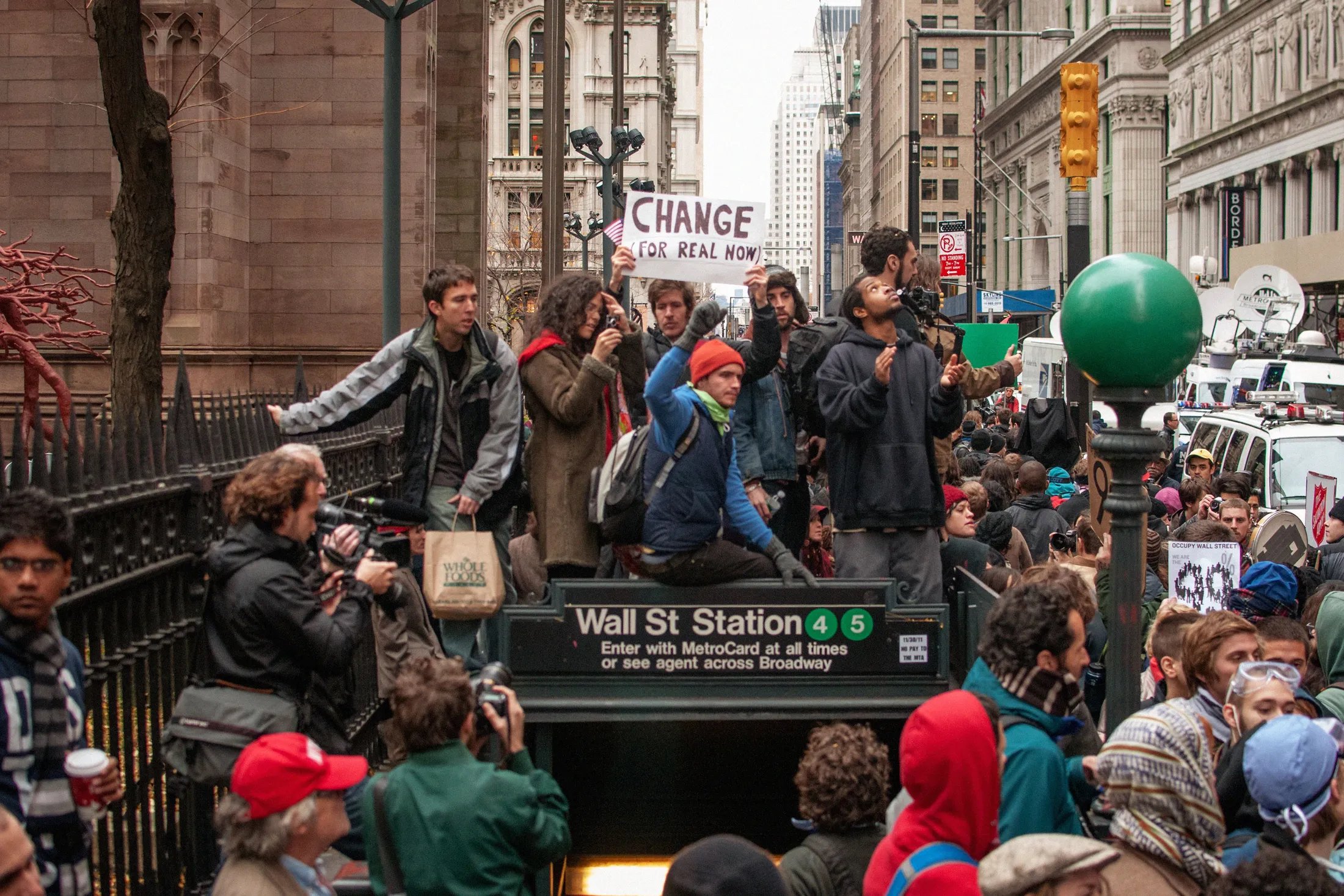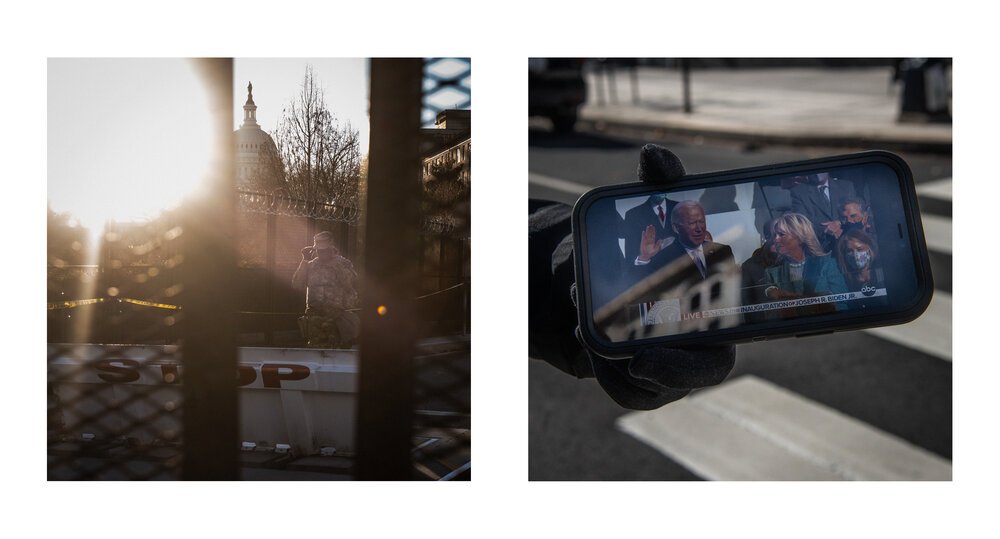SELECTED PHOTO
PUBLICATIONS
Written by Astra Taylor and Jonathan Smucker, with Photographs by Tracie Dawn Williams, published in New York Magazine on September 17, 2021.
Excerpt: On August 10, 2011, the late David Graeber sent Astra an email that read, in part: “by the way, you should join us in our general assemblies leading up to the Wall Street actions. We have a genuine horizontal structure up and running and it’s really fun (for geeks like me anyway).” Graeber, an anthropologist by trade, was part of a loose group of a few dozen people meeting regularly that summer in response to a call, issued by a Canadian countercultural magazine called Adbusters, for 20,000 demonstrators to descend on Wall Street on September 17. (The date was rather arbitrary: It was the birthday of the mother of one of the magazine’s editors.) The announcement instructed people to bring tents and stay “for a few months.”
Originally published on Tribes.org in July 2021. Pitched, photographed, and written by Tracie Dawn Williams.
Although I was little apprehensive of the masses that Pride draws, my yearning for human connection on a fundamental level superseded my fears. As I navigated the collective awkwardness of emerging from isolation, I joined pre-march festivities in lower Manhattan under the blazing midday sun. Within a landscape adorned with a sea of rainbows, boisterous music and spontaneous dance parties, there was an atmosphere of freedom, acceptance and pure elation. New Yorkers are creatures who thrive on our shared magical, sometimes very brief, experiences and the excitement of returning to our lives pre-Covid was palpable.
I then made my way to Bryant Park to join the march that culminated in a beautiful cacophony of debauchery in Washington Square Park. As I meandered and mingled, there was a sense that people not only wanted, but needed to be seen. The energy was electric and the joy was infectious. And nothing else mattered, but being there with, and for, one another. It felt as though there was an unspoken understanding that our liberation and happiness were interconnected. After all, there’s nothing like celebrating life and love, while dancing in the streets with strangers.
Originally published on Tribes.org in January 2021. Pitched, photographed, and written by Tracie Dawn Williams.
After four turbulent years, Trump left behind a fortified city and a mortified nation. Streets usually filled with jubilation, demonstrations and sometimes confrontations, were nearly completely empty save for the members of the press and a few on-lookers. The Natioal Guard, Secret Service and Capitol Police secured the perimeter that extended far beyond the White House, Capitol Hill and the Washington Monument, awaiting a second mob of pro-Trump insurrectionists which never manifested. Journalists had spent weeks preparing to report in a hostile environment, zooming security trainings that would usually be reserved for war-time reporting, and toting helmets, gas masks and bullet proof vests now rendered superfluous. In a desolate intersection, with only two other photographers, I watched Biden be sworn in as the 46th President on an iPhone, as the usual inaugural fanfare was limited to only a few. At this moment the air began to shift and become lighter. A country now somewhat at ease, but not totally at peace. Moved by the spoken words of Amanda Gorman I recalled just hearing moments before, there was some sense of hope. “If we merge mercy with might, and might with right, then love becomes our legacy.”
Residents of Morris County, N.J., aren’t waiting for federal relief—they’re helping each otheR
Originally published in The Nation on December 10, 2020. Pitched and photographed by Tracie Dawn Williams, with text by John Washington.
“In Morristown County, the lack of decisive action at the federal level has left people to fend for themselves. But they haven’t been doing so alone: For months, residents here have organized to help their most vulnerable neighbors. Through creative fundraising and the special kind of community that forms when neighbors help their neighbors, Mutual Morris, a mutual aid group with a roster of over 100 volunteers, is providing a lifeline for about 500 households during a very dark time. Just after the first wave of the pandemic receded, photographer Tracie Williams and I met with some of these families.“
Originally published in The Nation on January 29, 2019. Pitched and photographed by Tracie Dawn Williams with text by Sophie Kasakove.
“Tevina Willis is among the the local leadership of one of New York City's largest public housing complexes, who, despite bureaucratic setbacks to update and repair buildings damaged by Superstorm Sandy over 6 years ago, have been active in preparing and creating a more resilient community should a similar catastrophic event occur. A Red Hook Houses resident of 10 years, Tevina was among the first graduates of the inaugural “Local Leaders”, a training program hosted by the Red Hook Initiative, in collaboration with local residents, and developed in direct response to lessons learned during Superstorm Sandy. The training consists of both immediate response to disaster and how to invest in long-term recovery strategies in the community. Prior to the storm, Tevina was organizing NYCHA residents in Williamsburg and Greenpoint, where she started her own non-profit training people to organize and advocate for themselves so that they “sit at the table and be apart of the decision making process that directly affects them.”
Originally published in The Intercept on December 16, 2018. Photographs by Tracie Dawn Williams, with text by John Washington.
“ERIC AND HIS wife, Oneida, took turns pushing a stroller and carrying or walking next to their two sons for nearly 2,500 miles, from southern Mexico to Tijuana. The Honduran couple and their boys, 9-year-old Kelvin and 18-month-old Julian, arrived in mid-November, shortly before winter rainstorms soaked the camps of thousands of people who have arrived at the U.S.-Mexico border as part of refugee caravans in the last few months."
Originally published in The Nation on December 14, 2018. Photographs by Tracie Dawn Williams with text by John Washington.
“Members of the migrant caravans, stranded in Tijuana, explain why they traveled thousands of miles from their homes.
“We don’t want to be separated. The ones most psychologically affected [if we get separated] are going to be the kids. They’ve already lived through too much trauma. We don’t want anymore.”
Patricia, 28, from San Salvador, El Salvador, with Emi, 10, and Carlitos, 3. Her husband was out working as a day laborer when we photographed them.”
Originally published in The Nation on April 26, 2018. Pitched and photographed by Tracie Dawn Williams.
According to an investigative report published by the Washington Post, in the 19 years following the Colombine High School Massacre, more than 210,000 students in 213 schools have experienced gun violence, at least 131 children, educators and other people have been killed in assaults, and another 273 have been injured. In 2018 alone, there have been 13 school shootings.
On the anniversary of this horrific tragedy, April 20, 2018, high schoolers from across the nation walked out of their classes to take a stand against gun violence. I had the amazing opportunity to hang out with kids from all over New York City who converged for a rally in Washington Square Park—hearing first-hand their fears, concerns and aspirations. This was a heartwarming and sobering experience.
Originally published in The Nation on March 30, 2018. Pitched, recorded, photographed and written by Tracie Dawn Williams.
My grandmother Mimi lived off a dirt road in a village 20 miles south of Albuquerque, New Mexico. Her family homesteaded to New Mexico in the early 1900s and she survived the Great Depression, two world wars (one of which she lost a son), the Korean War, the Vietnam Conflict, and the Gulf War. She used to compose the most beautiful quilts for the state fair, of which she always took home a ribbon. Her yard overflowed with rose bushes of every color and she tended to them with loving care. Mimi was an independent, self-sufficient woman hardened by time and experience. But after my grandfather’s Alzheimer's became too much for her to manage, he was placed in a home and she was then alone. Meals on Wheels volunteers paid her a visit everyday for 15 years, bringing her a hot meal, companionship and a sense of security that someone would be there to check on her well-being, god forbid something were to happen. Mimi died in her home, in hospice, at the age of 91 in May of 1997.
Originally published in The Nation on February 16, 2018. Photographs by Tracie Dawn Williams, with text by Zoë Carpenter.
In March 2017, I returned from a month-long, self-funded embed in Standing Rock where I was living and documenting the main resistance camp of the Dakota Access Pipeline protests, just north of Cannon Ball, North Dakota. On Feb 23, 2017, law enforcement arrived with snipers, ituated on the roofs of Humvees, dressed in camouflage and armed with automatic weapons to systematically clear the camp. I was arrested while covering the militarized raid that took place there, moments after the image (above) of the two Water Protectors praying near the Sacred Fire - with weapons aimed at their heads, point-blank range - was made.
In addition, my camera, lenses, audio recorder, memory cards and cell phone were confiscated as evidence. With perseverance and support from NPPA's General Counsel Mickey Osterreicher and Matt E Kelley, a media lawyer from DC, along with many advocacy groups including the National Press Photographers Association, Committee to Protect Journalists, Native American Journalists Association, Online News Association, The Society of Professional Journalist and State Senator Tim Mathern, I managed to get all of my gear back (data intact) literally hours before jumping on a plane back to NYC. I was charged with “Physical Obstruction of a Government Function,” which is a Class A Misdemeanor offense carrying a sentence ofup to one year in jail and/or $3k fine. 18 months later, my case was dismissed.










